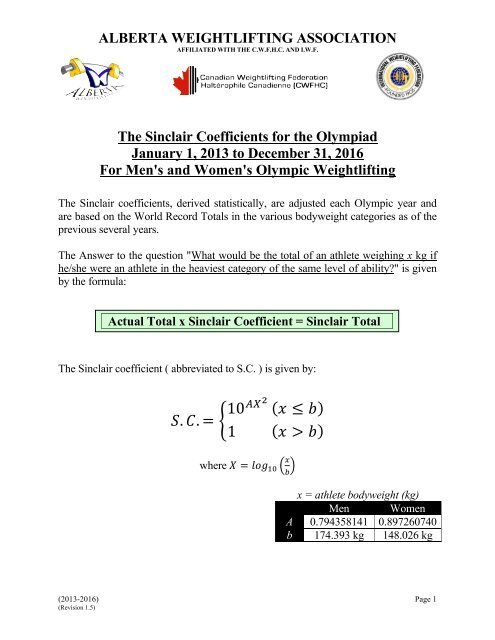Sinclair formula
What is it exactly ?
The Sinclair Formula is a mathematical formula Paper used in Olympic weightlifting to compare the performances of lifters across different body weights. The purpose of the Sinclair Formula is to provide a fair method to determine the best overall lifters, regardless of their body weight category Explain.
It was created by Dr Sinclair and adopted by the International Weightlifting Federation (IWF) in 1979 and still used worldwide.
How it works ?
The Sinclair Formula relies on coefficients that are derived based on the world records in the sport. Those coefficients change periodically (usually every Olympic cycle) to account for new world records.Purpose of the Sinclair formula
The primary use of the Sinclair Formula is in competitions where there's a need to compare athletes across different weight categories, like in determining the best overall male and female lifters of a tournament.
It's worth noting that while the Sinclair Formula is widely used and respected, no formula is perfect, and there are always ongoing discussions in the weightlifting community about the best methods to compare performances.
Athlete total * ( 10^( A * ( ( LOG10 ( Athlete bodyweight / b ) )^2 ) ) )
Calculate your Sinclair by period
Hum tell me more
In olympic weightlifting, it's obvious that heavier athletes tend to lift heavier weights. However, comparing performances across weight categories is not straightforward.
You cannot just compare the ratios of the weight lifted with the bodyweight of two athletes to determine who is the best athlete between the two.
Why ?
Because you cannot compare oranges and tomatoes. The two athletes have different physique that can impact greatly what weight they can lift. And what can represent that different physique ? The bodyweight.
So you have to put the two athletes on the same base, the same bodyweight to then determine which athlete could lift heavier while the two athletes having the same "physique".
If a lighter lifter lifts almost the same weight as a heavier lifter, the performance of the lighter lifter is generally considered more impressive.
The Sinclair Formula aids in making such comparisons by producing a coefficient that can be multiplied by a lifter's total to give a Sinclair Total, effectively leveling the playing field for all weight categories.

Who's Dr Sinclair ?
Dr Roy Sinclair was a canadian mathematician and passionate by the sport of olympic weightlifting. He studied at the university of Alberta and then attended the Massachusetts Institute of Technology (MIT).
Living in Alberta and active member of the Alberta weightlifting association, he developped a mathematical formula, the Sinclair formula, a statistical method that identifies the athlete who, pound-for-pound lifts the most weight
First Canadian official to become qualified as an International Weightlifting Federation #3 official and the first to reach #1 official certification allowing him to referee up to and including the Olympics, Dr Sinclair never stop to be involved in olympic weightlifting until his death in 2011.

